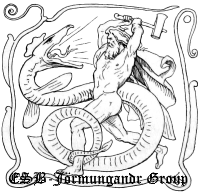ESB-Jörmungandr Group
The ESB-Jörmungandr Group of Teldrin of Ynnraile (formerly Lunaris) is a trading company under warrant of the Kingdom of Goldshire. The ESB Group's ostensible remit is to serve as a Joint Stock Company trading in goods, commodities and services on the Benacian Continent.
The company was established by articles of association signed by Thorgils Tarjeisson, Daniel Dravot & Dr Ernst Cryptsinger on Izillare, 2 Gevrader 1634, at the saloon bar of the Bethlem Hotel, Teldrin. In light of recent corporate reorganization, it is now referred to within the Company as the Benacian Directorate.
One tenth of all profits derived by the activities of the ESB Group are remitted to the King of Goldshire, Ryker Everstone.
Merger of Einhorn–Silverman–Bochs Group and Jörmungandr A/S.
Headquarters
The Seat of the Board of Directors is stipulated to be in Teldrin, Ynnraile and corporate offices were originally established in the suites of the the Bethlem Hotel (Formerly Bethlem Lunatic Asylum).
In 1635 the Group commenced the construction of the 'Sanitorium' in Teldrin as a fortified residential cantonment for employees based in Lunaris who wished to retain their sanity in the midst of a population of habitual lunatics. The company offices were relocated to the Sanitorium upon its completion in 1637. Since then the site has successfully withstood two sieges, the first by the Army of the Golden Dawn during the Civil War in Goldshire and the second by the supporters of Lord Adam during the Year of the Four Kaisers.
The Sanitorium, so named as a pun to imply a sanctuary from the lunacy of the surrounding countryside, is fortified by three walls with the fourth side being bounded against the Red Elwynn itself, where an artificial ferroconcrete platform projecting out into the slow flowing waters of the Benacian mega-river constitutes the fourth wall in all but name. The cantonment itself was built on a terraced raised platform of 310,000 cubic metres of concrete, clad with imported limestone, enclosing an area of thirty-eight acres, filling the gap between two mounds, confirmed by archaeologists to be the remnants of ancient settlements dating back 3,000 years pre-Norton.
The walls, formed of ferroconcrete segments faced and clad by gleaming silver-gilded limestone, reached a height of ten metres capped with an extra two metres of crenellations on top, over each gate set in the walls, corresponding to the points of the compass, north, east, and south, had been set ferroconcrete barbicans clad this time in granite so as to give them an ominous distinction from the walls set behind them. These barbicans rose to a height of twenty-five metres, which is roughly equivalent to three Shirekeep omnibuses stacked one atop of another. It should be recalled however that these walls have been set atop of the retaining walls of the Sanatorium's raised platform which continue for another thirty metres below ground level.
The dressed stones of the walls, silvered and finely chiselled, have been decorated with a variety of Euran and Benacian cultural motifs, including depictions of the World Serpent, the Benac, the Cedrist Pantheon, and various Shahs and Kaisers shown in the act of ritually dispatching myriads of opponents, usually human or daemonic, thus earning the favour of the gods, whose winged servitors are depicted overhead offering gestures of benediction whilst stylised representations of the various nations of the world prostrate themselves in homage before the fearsome scene of carnage. The barbicans, by contrast, break up the monotony of black granite with veins of gold-leaf laid out in a variety of geometric patterns radiating from the archway of the gate and spiralling upwards along the base of the circular towers. Although the walls and their various towers are mostly decorative rather than practical fighting platforms they do however serve a useful purpose in providing a vantage point for observation over the town and surrounding countryside, as well as facilitating the installation of surveillance equipment, including close-circuit TV cameras, signals monitoring equipment and radio direction finders, along with masts, apparatus, arrays, and apertures belonging to various other undeclared devices.
Set into the two landward corners of the walls are however two functional buildings particular to the Euran cultural mindset – the circular flaktowers “Dominus” and “Aurangzeb” stand at a height of fifty three metres and mount eight point defence autocannons alongside a vertical launch system for twenty-four interceptor missiles. Each tower has a multi-function dual-face active electronically scanned array radar which can be retracted behind a thick concrete and steel dome for protection. The walls of the towers are four metres thick.
Although denied, rumours persist, that the visible portion of the Sanatorium is in fact merely the tip of a vast buried ziggurat. These rumours are typically described as fanciful by ESB representatives who point out, not unreasonably, that the Group is not blessed with unlimited cash reserves to splash on dubious vanity projects.
The internal portion of the Sanatorium, known as the Cantonment, is divided into four portions. The first, comprised of the western projecting platform, is reserved for storage facilities, security offices, and the landing pads for gravimetric vehicles and helicopters. The remainder is organised into concentric layers, the outermost being the residential area comprised of fifteen terraced blocks set amidst a landscaped zone of water features and green squares. The main buildings rise up to seven floors above a podium level which forms a pedestrian concourse connecting the residential area, progressing inwards, to the cultural zone. The heart of the cultural zone is the Noor Madrassa, a school for the children of ESB employees built in the Neo-Babkhan style favoured in Alalehzamin, which also serves as a venue for arts and cultural activities for the entertainment of adult residents. The cultural zone also includes a finishing school for Loyal Subjects of the company, from where ESB employees can identify and select prospective marriage partners upon graduation.
A portico or colonnaded covered walkway divides the cultural zone from the administrative district, a palace complex built as a basilica with four rows of columns running lengthwise, each made of 40 columns, thus creating three parallel halls, with a central fourteen metres wide hall and two flanking nine metres wide halls, with the central hall being twice as tall as the aisles, at nearly thirty-three metres in height. The whole structure was set amidst walled paradise gardens with discrete alcoves reserved for the pleasures of senior ESB employees.
Organisation
The Group is organised into ten Directorates subordinate to the Board of Directors, these being:
| Directorate | Function | Employees |
|---|---|---|
| Secretariat: | Reports to the Secretary to the Board of Directors. Supporting the Board of Directors of the ESB Group in following the obligations enjoined by the Articles of Association and the Grand Ducal Warrant upon the aforesaid board. Additional duties include the Organisation and Internal Governance of the Group and it's directorates. Prospectors and Observers, both resident and itinerant, report directly to the Secretary of the Board of Directors and thus belong under the Secretariat's Pay-Roll. | 1,802 |
| Directorate of Security | Close Protection of ESB Group corporate officers, personnel and property | 14,440 |
| Directorate of Apollonian Operations | Provision of commodity, logistic, and outsourcing services in Arboria, Saint Andre, and Oranje | 12,873 |
| Directorate of Benacian Operations | Provision of commodity, logistic, industrial, and outsourcing services in Shireroth, and military and technical advisory support in Kasterburg | 106,882 |
| Directorate of Euran Operations | Provision of military, logistic, technical, and industrial support services in Constancia and Raspur | 42,904 |
| Directorate of Keltian Operations | Provision of commodity, logistical, industrial, military, outsourcing, and technical support services in Caputia, Elijah's Rest (Normark), and Wechua | 92,871 |
| Directorate of Tapferite Operations | Provision of commodity, logistic, and outsourcing services in Natopia | 470 |
| Tarjeisson Trust | Administering the estate and endowments of the late Kaiser Dominus | 804 |
| Tarjeisson Complex Marriage Trust | Administering the estate bestowed upon the wives and children of the late Kaiser Dominus | 30 |
| Directorate of Financial and Legal Services | Provision of financial and legal services, as well as associated consulting services, internally to the Group and externally to select clients | 200 |
Former directorates of Commodity Services, Logistic Services, and Outsourcing Services were disbanded in 1662 with their functions being reassigned to the continental operations directorates.
Personnel
As of 1662 the ESB Group employed 273,076 members of staff, not counting contractors, sub-contractors and short-term hires.
Board of Directors
| File Photograph | Director's Name | Post | Area of Operations | Employee Number |
|---|---|---|---|---|
| Daniyal ibn Daniyal Simrani-Kalirion | Chairman, Director of Benacian Operations & Director of the Tarjeisson Trust | Modan Hamlet, State of Modan | 1662-273069 | |
| Roy Stone | Secretary to the Board of Directors | Goldshire | 1662-273070 | |
| Timūr al-Osman Taraghay | Director of Security | Raspur | 1662-273071 | |
 |
Jaime Augustin Joaquin Primo de Aguilar | Director of Financial and Legal Services | Vey, Constancia | 1662-273075 |
| Michael Humphrey | Director of Apollonian Operations | Port Saint Andre, Natopia | 1662-273072 | |
 |
Sarah Dravot | Director of Euran Operations | Constancia | 1652-34051 |
 |
Royston Merrick the Younger | Director of Keltian Operations | Teldrin, Goldshire | 1645-22140 |
| Isabella Simrani-Kalirion | Director of Tapferite Operations | Lindstrom, Natopia | 1662-273073 | |
| Eliza Carstens | Director of the Tarjeisson Complex Marriage Trust | Mohamedion, Alalehzamin | 1662-273074 | |
 |
Liv Dravot-Osman | Non-Executive Director | Ardashirshahr | 1645-23450 |
 |
Ryker Everstone | Non-Executive Director | Goldshire Hamlet, Goldshire | 1651-33002 |
| Ayreon IV Kalirion | Non-Executive Director | Goldshire Hamlet, Goldshire | 1662-273068 |
Notable Employees
Notable Former Employees
The mortality rate of the ESB Group has been somewhat higher than might otherwise be expected of a large-scale corporation.
Reginald Smythe (Employee Number 1635-346), a prospector assigned to the Southern Islands was kidnapped by the Tegong of Jingdao and his body mutilated in a manner consistent with an internal bomb blast before his remains were deposited at the scene of a staged suicide bombing in the Imperial Assembly of Epoli. As a consequence of the abduction and murder of one of its employees the ESB Group in late 1635 created the Security Directorate to improve the safety of its workforce, at home and overseas.
Ernst Cryptsinger (Employee Number 1634-003), one of the founding partners of the company, Doctor Cryptsinger served as Director of Finance and Outsourcing before becoming Martial Law Administrator of Goldshire. He was caught in Goldshire Hamlet when a mutiny swept the Goldshire Regulars and died defending the Palace at Goldshire Hamlet whilst various heirlooms and artefacts were evacuated by order of Queen Noor.
In 1641 Deimos Jasonides (1634-004), Secretary to the Board of Directors and an Admiral in the Imperial Navy, perished in a contrived rebel suicide attack[1] on the cruiser ZNS Kaiser Agni I as it laid at anchor in MoMA Station Sabatini. Thorgils Tarjeisson, Deimos' employer twice over as Chairman of the ESB and MoMA of the Ministry of Military Affairs, spared no expense in hiring necromancers in an attempt to resurrect his formerly indispensable factotum; some say it was in order to punish his negligence in leaving a crucial naval base unsecured, others maintain that it was in order to torture from him the details of the secret accounts into which the Secretary had been siphoning misappropriated revenues that rightfully belonged to the ESB group. Both accounts are correct but the attempt was unsuccessful and the bodily remains of Admiral Jasonides were released in preparation of a state funeral, to be held in Shirekeep during the year 1642 AN.
Thorgils Tarjeisson (1634-001), the founder and chairman of the ESB Group, rose to fame and power as Kaiser Dominus, however he remained blind to the dangers posed by his allies Adam Ayreon-Kalirion, Tokaray al-Osman and Ludovic Verion until virtually the last moment and thus perished miserably, digested into the corporeal form of a newly manifested daemon, during the Oustfest Massacre.
Laqi Hyrrion (dec'd) (1634-902), notable, if not infamous, as the Itinerant Observer dispatched by the ESB Group to gather and transmit back to Teldrin any designs and or discoveries that might advance the economic interests of the Group. Although he scored notable early successes that advanced Shirerithian submarine designs by a generation, he was quickly discovered and compromised by the Minarborian authorities. Although useless for the purposes of corporate espionage, Laqi was nonetheless able to establish himself on the fringes of Minarborean polite society, obtaining a certain degree of notoriety as the first Revenant to install a putrefact into his own body for the purpose of rediscovering the joys of digestion. Subsequently dispatched to Dietsland on Imperial Service where he rose to the rank of Dux in the Imperial Army and advising the Confederacy of Puritanian States through the offices of the Puritanian Guidance Authority which he was instrumental in creating. Deposed in a local coup organised by Waldemar Zinkgraven during the Year of the Four Kaisers he was butchered and decapitated by the mutineers; subsequently his head was retained by Waldemar as a memento of the occasion. It is unknown whether Laqi, as a Revenant rather than a Lich, will ever regenerate.
Marcellus Paixhans (1635-01003), First Director of the groups Euran Directorate, a noted inventor and naval engineer - responsible for the design and manufacture of improvised weapons systems such as the infernal machines (floating mines) and armoured land cruisers which helped the Constancian Home Guard to successfully resist the full onslaught of a Jingdaoese invasion. Murdered along with his wife in separatist riots which swept Nivardom in 1648.
The company's typing pool is rumoured to be running a sweepstake on which of the directors will survive to retirement or die of natural causes.
Daniyal Dravot (1634-002), Thorgil's successor as Chairman, succumbed to the effects of a severe intracerebral haemorrhage whilst praying in the Sanctum of Malabor, located in the Yoni Temple complex of Modan-Lach. His retainers were able to rush the stricken Chairman to the temple's on-site clinic, but Dravot was declared clinically dead whilst doctors were attempting a dural puncture in order to conduct an extraventricular drain.
Huldah Llynadorion (1634-148), former Resident Observer in the then Duchy of Raikoth, and subsequently Secretary to the Board of Directors and Director of Financial Services, was the first notable employee of the Group to reach an age where she could, prudently perhaps, elect for early retirement. A discrete and remarkably uncontroversial servant of the company it is said that she learned from the example of Laqi Hyrrion at an early stage the importance of maintaining a low profile. Her refusal to engage in the internecine factional in-fighting so beloved of other members of the board enabled her to maintain her position as secretary to the board. Similarly her discretion ensured that she continued to be entrusted with the Group's complex and deliberately opaque finances. A trusted confident of Daniyal Dravot during his lifetime, based on shared reminiscences of their respective experiences of working alongside the "characterful" revenant Laqi Hyrron, Huldah was known to disapprove of his second wife and found the tenure of Liv as Chairwoman of the Group to have been an ordeal. Llynadorion's success in transferring the title deeds to key assets offshore, via financial vehicles such as the Gainshare Capital Holdings company registered in Raspur, proved instrumental, along with a series of gun battles between the ESB Security Directorate and Imperial Marshals in Teldrin and Shirekeep, in thwarting an attempt by the Ministry of the Interior to confiscate the capital and infrastructure assets of the company during the Elwynnese Civil War. For this diligence she received a commendation from the board and the keys to a villa on the island of Amity to where she retired in 1662 following twenty-eight years in company service.
Subsidiaries
| Company Name | Area of Operations | Activity | Estimated revenues | Parent Directorate |
|---|---|---|---|---|
| Amity Shipyards Ltd | Erudition, Jadid Khaz Modan | Shipbuilding | . | . |
| Teldrin Mint | . | . | . | . |
| Imperial & Emirati Bank of Alalehzamin and Constancia | Eura | Universal and commercial banking, financial services | Classified | Euran Operations Directorate |
| Bountiful Harvest Ltd | . | . | . | . |
| The Tarjeisson Foundation | . | . | . | . |
| ESB Group (Keltia) | . | . | . | . |
| Atacama Corporation | Eura | Consulting and property management | Classified | Euran Operations Directorate in partnership with Oranjesion Private Equity Capital & Thema Oranjesion |
| Raspur Airport Ltd | Eura | Airport operations and facilities management | . | Euran Operations Directorate |
| ESB-MPFR Fisheries & Commerce Protection Squadron | Eura | Inspection, verification, testing and certification services, fisheries and commerce protection | Classified | Euran Operations Directorate |
Current contracts
| Contract | Contract Value | ESB Directorate | Awarding Authority | Activity | Year Awarded | Contract Duration |
|---|---|---|---|---|---|---|
| Teldrin Trade Monopoly | No Fixed Value | Commodity Services | Kingdom of Goldshire | Monopoly on all goods, commodities and services to and from Teldrin | 1634 | In perpetuity subject to per annum remittance of ten percent of all profits to the Crown |
| Royal Government of Goldshire | No Fixed Value | Outsourcing Services | Kingdom of Goldshire | Public Administration | 1635 | In perpetuity, subject to Royal discretion |
| Amity Ports Authority Ltd | No Fixed Value | Outsourcing Services | Emirate of Amity, Mirioth & So-Sara | Construction and civil administration of the dockyards operated by the Boat Yards of Amity Ltd | 1635 | 12 Elw Years with options to lease back facilities. Now operated in partnership with House of Osman GmBH. |
| Shrubway (Shireroth) Ltd | No Fixed Value | Financial Services | Church of Minarbor/Third State Arbour (Empire of Minarboria) | Franchising authority for vendors of the Shrubway fast-food chain in the Imperial Republic of Shireroth | 1635 | Wholly owned following the demise of the Church of Minarbor. |
| Port and Harbour Operations and Management, Eura | No Fixed Value | Euran Operations Directorate | Government of the Free and Associative Kingdom of Constancia | Construction, Operations Management, and devolved Customs and Excise Services | 1655 | 20 Elw Years |
Former business activities
| Contract | Contract Value | ESB Directorate | Awarding Authority | Activity | Year Awarded | Contract Duration |
|---|---|---|---|---|---|---|
| Teldrin Mint | 12.2M Teldrin Thalers (Th) | Financial Services | Worshipful Corporation of Aldermen for the City of Teldrin | Production and Circulation of Teldrin Thalers | 1634 | Expired 1644. Continues as wholly owned subsidiary. |
| Teldrin Transport Docks Board Ltd | 2.795M Th | Logistic Services | Worshipful Corporation of Aldermen for the City of Teldrin | Management of Teldrin Dock & Associated Warehouses | 1634 | Expired 1641. Reverted to local authority control. |
| Imperial & Emirati Bank of Alalehzamin | 400M Th | Financial Services | Emirati Government of Alalehzamin and Utasia | Banking Services to the Emirate of Alalehzamin & Utasia | 1634 | Expired 1644. Operated as wholly owned subsidiary. Divested in 1661 to Gainshare Capital Holdings. |
| Bountiful Harvest Ltd | 16M Th | Financial Services | Emirati Government of Alalehzamin & Utasia | Management of the 400M Th Sovereign Wealth Fund of the Emirate | 1634 | Contract expired 1654. Operates as wholly owned subsidiary. |
| Boat Yards of Teldrin Ltd | 3.96B Th | Logistic Services | MoMA | In-Service Maintenance of the eleven Duchy Class Destroyers of the Imperial Shirerithian Navy | 1635 | Ended 1655. |
| Boat Yards of Amity Ltd | 3.48B Th | Logistic Services | MoMA | Construction and In-Service Maintenance of the three Poltroon Class Submarines of the Imperial Shirerithian Navy | 1635 | Ended 1647 |
| County of Ran Public Insurance & Cudgelling Ltd | 2M Th | Outsourcing Services | Count of Ran | Property Insurance, Public Administration, Emergency Services and Law Enforcement | 1636 | Ended in 1640 with loss of Ran to rebel forces during Civil War in Goldshire. |
| South Sea (Ura'Bos) Company Ltd | No Fixed Value | Commodity Services | The Kaiser | Plantation of a Colony onto the Imperial Dominion of Ura'Bos for the purpose of trade with Natopia | 1636 | In perpetuity, subject to Imperial oversight. |
| ESB Imports | 17.9B Th | Commodity Services | Imperial Forces Union Defence Force Goldshire Regulars |
The reassembly, reverse engineering and unlicensed reproduction of military hardware acquired from sources of dubious veracity. | 1649 | Terminated by Shirerithian Supplies Service following anti-corruption investigation conducted by the Chamber of the Crypteia. |
| Cedrocomando S.A. | 39.5B Erb | Outsourcing Services | Ministry of Military Affairs | The creation of the Cedrocomando Security Force within the Shirerithian Condominium of Greater Tellia. | 1641 | Ended 1651. Incorporated into Imperial Forces |
History
Some jurisdictions have questioned the presence of paid Observers in their ports - considering them to be either a nuisance on a par with impertinent news correspondents or else as poorly disguised practitioners of industrial espionage.
Although the ESB-Jörmungandr Group has no openly declared rivals its monopoly on trade with Teldrin is not favourably thought of by would-be competitors. This, together with encouraging the River Trade bound between Shirekeep and Musica on the Red Elwynn to accept hospitality at Teldrin and for their Erb to be exchanged for Thalers in the pubs, hotels and brothels of the town whilst the goods they carried were repackaged for export under the ESB label, for which a fee was charged, has been considered by some to amount to sharp practice.
By operating the Teldrin Mint the ESB-Jörmungandr Group is also reported to have incurred the enmity of the Assayers of the Avakair Mint who consider the project to be little more than a systematic attempt to debase and supplant the hallowed gold-standard of currencies with worthless fiat money.
Operation Ithaca
Operation Ithaca commenced in 1636 when the ESB-Jörmungandr Group received a licence from the Basileusa of Constancia to mount an expedition to the city of Vey in the interior of the Euran Continent, for the purposes of examining a ruined Babkhan ziggurat as part of the Secretariat's ongoing Industrial Archaeology Programme - which focused primarily on salvaging technology from the many ruined civilisations of Micras. This expedition also marked the first overseas deployment of the Directorate of Security, to provide close protection for the archaeologists, at a time of heightened tensions between Jingdao and Constancia.
There were however critics of the operation who maintained that it served primarily as a cover for quasi-covert deliveries of weapons, munitions and spares, as well as technical experts and advisers to prop-up the Constancian Armed Forces during their war with the Empire of Jingdao.[2]
Furthermore the Euran War had, during the course of 1636, to eat away at the otherwise very healthy profit margins of the organisation. Leading to some internal discussion within the organisation as to whether the growth orientated business model was being undermined by increasingly political considerations.
The ESB Group neither confirmed nor denied that the disturbances on Walstadt in 1636[3], which resulted in the sinking of an ESB owned barque - the Seahawk, was a cover for an attempt on the life of the Jingdaoese Emperor. The Emperor, it should be noted, was siezed by a mob and decapitated by persons unknown, during the course of the brief tumult.
Paramilitary Activities

After rivalries with the Assayers degenerated into open warfare, the ESB Group became heavily involved with trying to prop up the Royal Government after it lost control of Lunaris, Elsenar and Ran. In so doing it was also directly implicated in the takeover of Amity and Yardistan by the faction of the Nationalist & Humanist Party led by Tokaray al-Osman and Isabella Simrani-Kalirion and the foundation of the Emirate of Jadid Khaz Modan.
In addition to the Directorate of Security, the ESB has also been involved in providing logistical and tactical support to the Jaysh al-Sathrati and in establishing the Cedrocomando private military company (PMC).
The Kaisership
The apogee of the ESB Group's power and influence in the Imperial Republic was seemingly reached in 1642 when its Chairman, ideally positioned after a relatively successful tenure as Minister of Military Affairs, unexpectedly acceded to the throne as Kaiser Dominus.
After the Oustfest
In the wake of the Oustfest Massacre and the death of Kaiser Dominus, the position of chairman of the Group was passed, in accordance with the Kaiser's last will and testament, to Daniyal Dravot, the surviving director from the founding trio of the company.
After the death of Daniyal in 1656 effective control of the Group passed to his wife Liv Dravot after a bare minimum of skulduggery amongst the directors.
In 1659 the ESB Group negotiated the largest slave purchase in history, purchasing the right to the entire Black Traveller community from the Khanate of Krasnarus for four trillion Erb ($62M). The entire debt servicing edifice of the Group strained to absorb the cost of the acquisition, but, at the stroke of a pen, the ESB Group had found the pool of manual labourers required for its programme of works on the Euran Continent.
Corporate rituals of the ESB
The corporate culture of the ESB Group encourages employees to dedicate themselves to its cause as a lifelong venture and to give their lives willingly for the Honourable Company should the circumstances necessitate it. It follows then that the ESB has built up a considerable corpus of rituals and lore, fused with certain more material incentives, designed to engender the utmost loyalty from those in its service.
ESB Martyrology
From the Euran War to the various civil conflicts in Shireroth as well as the dangers inherent in the literally cutthroat competition with such rival conglomerates such as the Octavyan Imports Company and the Iron Company a great many of the ESB's employees, shareholders, business partners, and associates have been called upon to make the ultimate sacrifice. In contrast to the blatant sanguinary cynicism which pervades the Imperial service, the ESB takes a care to honour its dead with appropriate gratitude and due ceremony.
New entrants into the company begin their indoctrination from almost the beginning of their training. The story of the Industrial Archaeology Expedition to Vey, and its role in turning the tide of the Euran War, is held up as the shining example for its members to aspire to emulate in their work, at whatever level they serve. A somewhat hagiographic account of the life of Marcellus Paixhans, the first Director of Euran Operations, is given to new employees as a strand that runs throughout their induction, and a theatrical account of his last stand and death at the hands of a rebel mob in Nivardom is shown on cinema night during the recruits' "decompression week" at the mid point in their basic training.
Moreover the junior employees of the ESB Group, as they finish their apprenticeships and probationary periods receive, along with their "commissioning scrolls", given in person by a member of the Board of Directors or a suitably senior deputy, a copy of the "ESB Book of Martyrs" listing those who the company deem to be the famous and or meritorious dead.
Nor does the ESB Group permit those ensconsed in the comfort of its corporate headquarters - the Sanitorium in Teldrin - to forget the sacrifices of those made in it is name by employees on the distant frontiers and in forgotten backwater ports. Martyred shareholder ritual: Shareholders attend in mourning clothes, entrance to a dirge, the meeting is solemnly called to order, the sad news is read, the bell is rung, hats are doffed and bows given to each individual name, then an adjournment.
In the lobby, more names are engraved, with a Zurvanite ritual of reading over the bones of the martyrs, inducting the fallen into their company, to be held in the side chapel for those who wish to attend.
An eternal flame is maintained in the Sanitorium, over the site of the ossuary and shareholders' crypt, with a ceremonial guard drawn from the ESB-Jagdverbande and the Jaysh al-Sathrati in continuous vigil at all hours of the day.
During the annual meetings, when the name of a departed shareholder is called, the corporate remembrancer replies in a loud voice, "Present, in spirit!"

